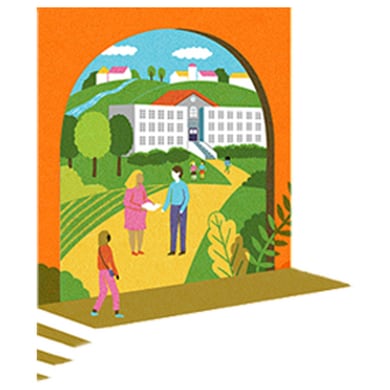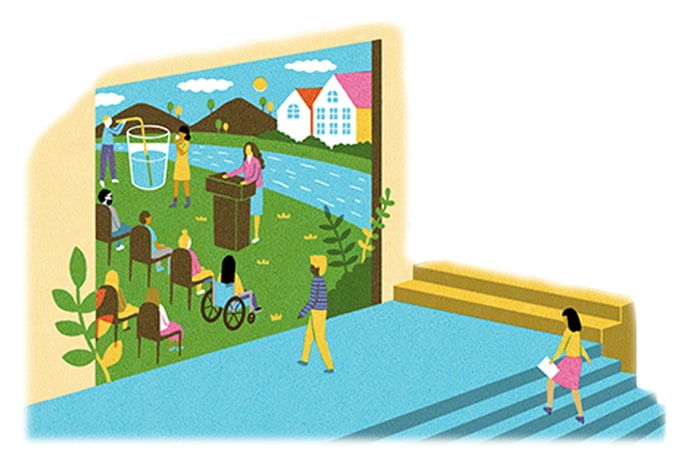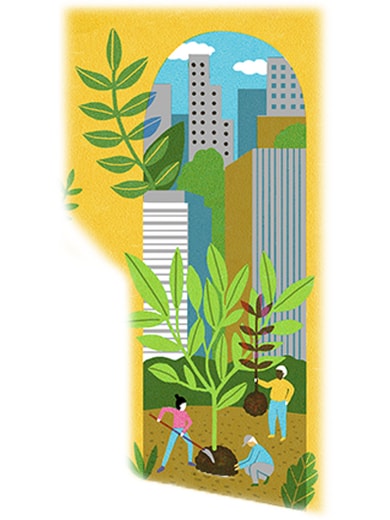
Three Careers Where Going Green Meets Social Justice
Meet three people with different jobs and educational backgrounds, united by a shared pursuit of environmental justice.
Alumni in this Article
Rachel Malarich (L.A. ’05) is a certified arborist and the city forest officer for the City of Los Angeles, where she oversees the growth of urban forest area. Malarich earned bachelor’s degrees in communications and Spanish from California State University, Long Beach.
Katelyn Roedner Sutter (G.N.O. ’09) works for the Environmental Defense Fund (EDF) developing policy proposals and doing legislative and regulatory advocacy around climate change and air quality. She earned a bachelor’s degree in international affairs from George Washington University and a master’s degree in ethics and social theory from the Graduate Theological Union.
Alexandra Manautou (Houston ’11) is an associate attorney at Earthjustice, a national environmental litigation nonprofit. Most recently, her work has focused on safer drinking water. She earned a bachelor’s degree in radio, television, and film from the University of Texas at Austin and a law degree from the University of Texas School of Law.
Environmental justice is defined as the fair treatment and meaningful involvement of all people with respect to environmental laws, regulations, and policies. Where does it show up in your work?
Malarich: To me, this work starts with listening to the issues that are important to the community, related to trees or not.
Sutter: Environmental justice doesn’t happen in a vacuum. It is linked to the cost of housing, the quality and existence of neighborhood schools, and the availability of family-sustaining jobs. All of this must be considered when making new environmental rules.
Manautou: This shows up in my work by keeping the focus on the voices and needs of our community member clients and staying cognizant of the fact that Black and brown communities are disproportionately impacted by environmental harms.
What’s one surprising thing you’ve learned about your community or environmental justice work so far?
Malarich: Everyone has a personal story about a tree. Some are positive. But for others, they see a tree and think of the time their grandparent tripped on the sidewalk because of an overgrown root, or they think of the high water bill their family had to pay because a ficus tree busted a water pipe. These trees didn’t do anything wrong; they were just planted in the wrong places. We must acknowledge these stories, especially when talking to people in low-income or high-risk communities, in order to make connections.
Sutter: California recognized the human right to water back in 2012, which in and of itself was a big deal and a pleasant surprise to me when I learned about it. But more surprising is that in 2019, in one of the wealthiest states in the U.S., there are people, mostly farmworker communities in the San Joaquin Valley, without access to clean drinking water.

What’s one of the daily struggles you face doing this work?
Malarich: Space. In affluent areas that already have a significant tree canopy, there is also better infrastructure that allows for more trees to be planted. In lower-income communities, there might be little or no parkway space for planting trees.
Sutter: An ongoing obstacle is when local elected officials with backgrounds in big agriculture and the oil industry are the same people who are appointed to regional agencies that govern transportation, air quality, and more.
Environmental justice is long-game work. Can you describe a short-game victory that indicates you’re making progress?
Malarich: Politicians repeating my talking points as their own. And when communities have every available planting space planted, with young trees thriving due to ongoing care.
Sutter: In one of my previous roles, I convened a local coalition to influence a regional plan for land use and transportation so that the plan would include metrics around air quality, health impacts, and equity. We were mostly successful—we even received an award for our community engagement. And that coalition still exists today.
Manautou: Environmental justice community members testifying before their congressional representatives demanding greater oversight of the chemicals in their everyday products.

What are we probably getting wrong when we think “environmental justice work”?
Sutter: I hear some mainstream environmentalists say the fight for environmental justice is separate from their work. I think all of us in the environmental space need to recognize that we cannot separate the fight against climate change from the fight for climate justice. We will always need to employ an array of tools and solutions, but we cannot ignore issues of justice and be successful.
Manautou: You don’t have to come into the field with a hard-science background. While a lot of the litigation work that I do does involve complex scientific issues, I learn a lot on the job and look to our staff scientist for guidance.
It seems like each day brings new anxieties about our climate future. When you’re overwhelmed, where do you turn for hope or reassurance?
Malarich: I spend time in nature, I stay fully present with my kids, and I’m encouraged by other local groups working on these issues. I feel like we all take turns holding onto hope for positive change.
Sutter: When leaders around the world seem to do nothing about climate change, 15-year-old Swedish activist Greta Thunberg’s movement gives me hope. She has a whole new generation talking about action in a powerful way. I’m also a person of faith, and hope is an important part of Pope Francis’s message on the environment. I draw strength from his message and leadership to stick it out when work is especially challenging.
Manautou: I look to women of color in politics who are frequently attacked, mocked, or singled out for being too “extreme.” Because of who they are and where they are from, they don’t have the privilege of being able to be moderate on certain issues. Their boldness and resiliency give me hope and energy.
What advice do you give others thinking of joining the environmental justice fight?
Malarich: I joke that I’m always looking to hire someone who is the right amount of jaded. This work is not easy, and change can take a long time. It can feel like we are too late or not moving fast enough. Take good care of yourself, build strong partnerships, and stay focused on the larger target.
Sutter: Environmental justice needs to be part of conversations that go beyond the environmental community. The local housing authority and school district need advocates for environmental justice. Even restaurateurs can be advocates. Many kinds of allies are essential to create systemic change in communities.

And what’s some advice you’d give people trying to lead greener lives?
Malarich: Think about one change you’ve wanted to make, like using a reusable lunch box or no more straws, and be honest about why you haven’t made the change. Is it an issue of time? Not having the right tools? Or do you just not want to? Identify your personal barrier to change, then see if another change might be more appropriate.
Sutter: My parents taught me about “needs versus wants.” They would meet my needs, but I couldn’t have everything I wanted. It’s a helpful reminder for me as I see global consumption get out of control. Do you need a new phone, or want one? There’s a place for wants, but we’ve forgotten the difference. And it’s having a catastrophic impact on our planet and the most vulnerable people.
Manautou: Focus on inclusivity. Don’t shame or judge people based on what “green” products they do or don’t use. Being a good steward of the environment is important, but there is very little any one single person can do that could reverse the current environmental crisis we are in.
How do you see your work continuing the mission of “One Day”?
Malarich: I’ve been able to improve the physical environment of high-need areas. With more trees, we lower youth asthma rates and students miss less school. And when youth are involved in planting projects, they feel agency in their community.
Sutter: The same communities struggling to get quality education are bearing a disproportionate burden of environmental damage. Working for justice in either education or the environment is transformational for the same people.
Manautou: Kids can’t truly succeed academically when they come to the classroom carrying the effects of environmental harms with them. A more just environment for overburdened communities is inherently part of “one day.”
Illustrations by Boyoun Kim
Sign up to receive articles like this in your inbox!
Thanks for signing up!
Content is loading...


